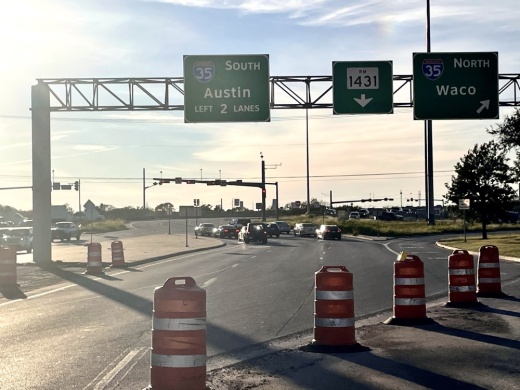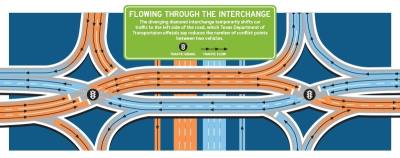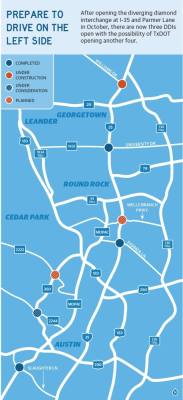“I think they direct the traffic really well to where you’re facing in the direction you need to go once you’re at the stoplight,” Viljoen said.
For Central Texans, DDIs are becoming more common, with the latest interchange opening at I-35 and Parmer Lane in October. That is because the Texas Department of Transportation sees it as an opportunity to alleviate congestion and improve safety on certain interchanges. Adam Kaliszewski, a district traffic engineer with TxDOT’s Austin district, said the design’s advantages stem from its ability to limit conflict points, or areas where two travelers are navigating the same space.
“When you have [fewer] conflict interactions, you’re able to allow more vehicles to move through these turning movements or these crossing movements more efficiently because they’re able to do so more frequently,” Kaliszewski said.
The design allows car traffic crossing the interchange to more easily make left turns onto and off of the highway.
TxDOT has already opened three DDIs throughout the Austin area: I-35 at University, I-35 at Parmer and MoPac at Slaughter Lane, TxDOT public information officer Brad Wheelis said. It also included a DDI in its I-35 at Williams Drive construction in Georgetown, a project scheduled to be completed by mid-2023.
On top of those four, it has plans to add two more DDIs: Loop 360 at RM 2222 and I-35 at Wells Branch Parkway (part of the Capital Express North project). It also is considering adding one at Loop 360 and RM 2244.
Impact on pedestrians and bicyclists
Susan Handy, a distinguished professor at the University of California, Davis, said projects designed to improve the flow of cars don’t necessarily reduce congestion.
“The point of these projects is to move more traffic, so that’s what they’re going to do. And if you move more [cars] you’re not getting rid of the congestion problem,” Handy said.
She added that the two proven ways to reduce congestion are employing pricing mechanisms, like tolls, and a pandemic.
Handy, who also serves as the director of the National Center for Sustainable Transportation, said the design does little to improve conditions for pedestrians and bicyclists. Planners need to consider the time that it takes to get to a destination, distance—pedestrians tend to only be willing to walk one-quarter mile—and access to sidewalks and bike paths, she added.
Currently, pedestrians can use raised sidewalks to cross the I-35 and University DDI but not MoPac and Slaughter. Pedestrian access is expected to be complete by February 2022 for the I-35 and Parmer interchange.
Kaliszewski said because the design requires pedestrians to make multiple crossings, there are better interchange designs for areas with more pedestrian traffic.
“In areas with very high pedestrian traffic, maybe near a university or an event, infotainment center area, it wouldn’t be as desirable there,” he said.
Handy also said speed is an important consideration to maximize pedestrian and bicycle safety, with the ideal speed limit at 25 mph on local streets. The TxDOT Austin district is using 20 mph speed limits on DDIs, according to a spokesperson.
Improvements on the margins
Mark Hallenbeck, director of the Washington State Transportation Center at the University of Washington, sees more advantages to the design, saying that while it will not solve congestion, it offers an important tool to chip away at the problem.
“It’s not that you expect to have a wonderful commute. It’s just that it’s way better than it would have been,” Hallenbeck said. “‘Hey, you’re going to average 35 miles an hour on the freeway instead of averaging 20 miles an hour. That’s still going to save you 15 minutes, but are you really going to notice it?’”
He added the design has significant safety benefits for drivers, as it tends to lead to more side-to-side crashes, instead of a car making a left turn in front of another car.
“When you hit somebody side to side that change in velocity is small, because you’re headed in the same direction, and you just bang into each other and the change in velocity is pretty minimal,” he said.
According to TxDOT data, the number of crashes at the I-35 and University Boulevard interchange has fallen by approximately 25% since it opened in 2015.
As for pedestrians, Hallenbeck said highway interchanges are inherently dangerous.
“I’m not aware that [DDIs] are actually worse than any of the other interchange designs for pedestrians and bikes, but freeway interchanges suck period for pedestrians and bikes, because the volumes are high,” he said. Haircuts and highway design
Ari Thomas is a shop manager at Birds Barbershop on Slaughter Lane, which sits just east of the MoPac and Slaughter Lane DDI. She said the design has been a pain for new customers.
“Usually what happens is that they’ll get confused thinking that there’s an entrance on the ramp over to Loop One, and then once they get to it and realize there’s not, they have to go down Loop One, all the way around and take a U-turn,” she said.
Thomas added that it can take 10 to 30 minutes to get back to the barbershop, which sometimes means they have to cancel the appointment. However, she admitted with time the more regular customers have grown accustomed to the design and no longer miss appointments.
Sam Trinh, a member of Nail Bar’s management team, has had a more positive experience with the DDI. The nail salon is located on the west side of MoPac and Slaughter. While he noticed some issues with customers getting turned around at first, he said the design seems to have reduced crashes.
“For me, it’s common sense,” Trinh said.







